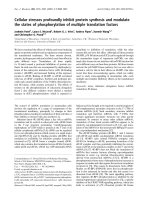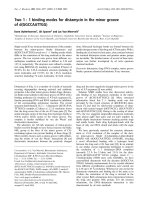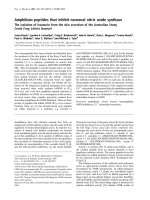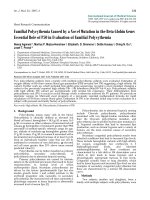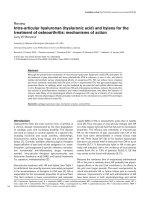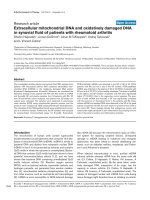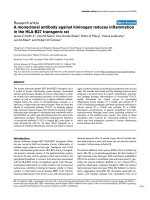Báo cáo y học: "Pro/con clinical debate: Is high-volume hemofiltration beneficial in the treatment of septic shock" docx
Bạn đang xem bản rút gọn của tài liệu. Xem và tải ngay bản đầy đủ của tài liệu tại đây (44.3 KB, 5 trang )
ARF = acute renal failure; CVVH = continuous venovenous hemofiltration; HVHF = high-volume hemofiltration; IL = interleukin; Q
UF
= maximum
ultrafiltration flow rate.
Critical Care February 2002 Vol 6 No 1 Reiter et al.
You have a 40-year-old male in your intensive care unit who has
septic shock as a result of bacterial pneumonia. He is on
moderate dose levophed to maintain a systolic pressure of 90
mmHg. Apart from respiratory and cardiovascular failure, he has
not developed any other end-organ failure. You feel confident
you are giving him the best supportive care possible; however,
his septic shock still bothers you. You remember hearing once
that HVHF may have a role in this type of patient to rid them of
the mediators that cause septic shock and to possibly improve
patient outcome, but you are unsure whether you should try it.
Commentary
Pro/con clinical debate: Is high-volume hemofiltration beneficial
in the treatment of septic shock?
Karl Reiter*, Rinaldo Bellomo
†
, Claudio Ronco
‡
and John A Kellum
§
*Professor of Pediatric Intensive Care, University Children’s Hospital, Muenchen, Germany
†
Director of Intensive Care Research, Austin & Repatriation Medical Center, Heidelberg, Victoria, Australia
‡
Professor of Nephrology, S. Bortolo Hospital, Vicenza, Italy
§
Associate Professor of Critical Care Medicine, University of Pittsburgh Medical Center, Pittsburgh, Pennsylvania, USA
Correspondence: Critical Care Forum Editorial Office,
Published online: 11 January 2002
Critical Care 2002, 6:18-21
© 2002 BioMed Central Ltd (Print ISSN 1364-8535; Online ISSN 1466-609X)
Abstract
Although there have been exciting advances in the management of sepsis and septic shock, mortality
still remains high. Recent data suggest that high-volume hemofiltration (HVHF) may play a role in these
patients. In contrast to the usual rate of hemofiltration, HVHF is felt to be better able to remove the
inflammatory mediators associated with sepsis and septic shock. Such an approach is currently
incapable of selectively removing specific mediators. This may be a problem when one considers that
several mediators may in fact be beneficial. When determining whether HVHF should be instituted in a
patient with septic shock, one need remember that its role is far from clear and its usefulness remains
the subject of much debate. Although early data is encouraging, it is clear that additional data is required
before HVHF becomes standard management. The authors of this pro/con debate, which is based on a
clinical scenario, first describe their own position and then respond to their opponent’s position.
Keywords hemofiltration, sepsis, septic shock
The scenario
Pro: HVHF is beneficial
Karl Reiter, Rinaldo Bellomo and Claudio Ronco
The sepsis syndrome is associated with an overwhelming
systemic overflow of pro-inflammatory and anti-inflammatory
mediators, leading to generalized endothelial damage,
multiple organ failure, and altered cellular immunological
responsiveness.
The inflammatory network is exaggerated, synergistic, and
acts like a cascade. It includes mediators with autocrine and
paracrine actions, as well as cellular and intracellular
components [1]. Some substances have a pronounced role
in the cascade. For instance, there is tumor necrosis factor-α,
Available online />IL-1β and IL-6 proximally, and there is reactive oxygen
species, nitric oxide, and nuclear factor-κB distally, to name
but a few. Antagonizing a single mediator has not, however,
reduced sepsis mortality in human trials [2].
Almost paralleling the surge of pro-inflammatory mediators,
there is a rise in anti-inflammatory substances by which a
state of immunoparalysis (i.e. ‘monocyte
hyporesponsiveness’) can be induced [3]. As both the pro-
inflammatory and anti-inflammatory sides become
upregulated and interact together, any intervention favoring
one side or the other is hazardous because, without ‘on-line’
measurements of the inflammatory status, the intervention
appears to be blind.
Continuous hemofiltration has been used successfully for the
treatment of acute renal failure (ARF) for years. Additional
advantages advocated in the treatment of sepsis comprise a
distinctly different concept, since a wider spectrum of
substances is targeted for removal. Uremic toxins are
targeted in ARF, whereas in sepsis pro-inflammatory and anti-
inflammatory mediators are sought to be removed as well as
uremic toxins.
Early animal studies delivered sound evidence that whatever
is removed by continuous venovenous hemofiltration (CVVH)
should be significant in terms of sepsis pathophysiology. This
is because re-infusion of the ultrafiltrate produced high
mortality in healthy animals with symptoms indistinguishable
from sepsis [4,5].
Numerous in vitro studies as well as animal and human
studies [6] have shown that synthetic filters used in
hemofiltration can extract nearly every substance involved in
sepsis to a certain degree. This occurs by convection and by
adsorption to the filter membrane, a process that is saturable
within a few hours. An augmentation can be reached by
increasing the membrane surface and the rate of
ultrafiltration, which probably extends the surface used for
adsorption more distally into the membrane pores [7].
In most studies, the decrease in the plasma levels of the
mediators is either absent or of a minor degree.
Nevertheless, early clinical studies in septic patients
demonstrated clinical improvement, albeit slight (for instance,
in their norepinephrine requirements). Increasing the
effectiveness of the treatment may be possible using either a
higher ultrafiltration rate with the filters currently available
and/or altering the chemicophysical properties of the
membrane.
A randomized, controlled clinical trial in 425 critically ill
patients with ARF showed that the ultrafiltration dose (rate
per body weight) correlated significantly with survival [8].
With an ultrafiltration dose of 20 ml/kg/hour, the mortality
was 59%. This compares with 43% mortality with a
35 ml/kg/hour dose and 42% mortality with a 45 ml/kg/hour
dose. This amounts, on average, to ultrafiltration of more than
2 l/hour, which should be designated HVHF. In each
randomized group in this trial, 11–14% of the patients had
sepsis; and in this subgroup there was direct correlation
between treatment dose and survival, even above
35 ml/kg/hour, in contrast to the whole group where a
survival plateau was reached with that dose.
This observation lends support to the concept of a ‘sepsis
dose’ of hemofiltration in septic patients, rather than a ‘renal
dose’ in critically ill patients without systemic inflammation;
the former probably being distinctly higher (without a proven
upper limit) than the latter. In sepsis, ultrafiltration at the rate
of 2 l/hour, even if applied very early, does not seem to be
sufficient [9].
Further recent human studies tested ‘sepsis doses’ of
ultrafiltration in the range 3.8–6 l/hour, demonstrating
increased survival and decreased vasopressor requirements
[10,11]. In a cohort of 20 patients with refractory circulatory
shock, short-term HVHF (35 l/4 hour) lead to an impressive
improvement in hemodynamic parameters and survival [12].
Patients with higher body weight showed less improvement,
possibly because they received a smaller ultrafiltration dose
per body weight.
Supporting evidence is provided by recent animal studies
that demonstrate significant hemodynamic benefit [13–15],
improvement in immune cell responsiveness [15], and
reduced mortality [14,15] with HVHF of about
80–100 ml/kg/hour.
How far have we come with these new data?
We believe there is a sound basis to recommend an
ultrafiltration dose of at least 30 ml/kg/hour in ARF in critically
ill patients. In patients with sepsis there is accumulating
evidence that hemofiltration, especially in the high
ultrafiltration range above 2 or 3 l/hour, may confer benefit.
This is in favor of the concept of removing as broad a range
of mediators (pro-inflammatory and anti-inflammatory) as
possible because there is clinical benefit, even if there are no
measurable decreases in selected plasma cytokine levels.
The probable theory behind this concept is that, with
continuous blood purification treatment, unmeasured (and
unknown) mediators (and probably existing but unmeasured
peaks in the plasma concentrations of known mediators) are
cut (the ‘peak concentration hypothesis’).
There are already encouraging results from refining the
technique by including higher molecular weight molecules for
removal. A new exciting avenue has been opened in plasma
filtration/adsorption techniques: biocompatible high-gain
adsorbing columns [16]. These enable more effective
removal of mediators in the borderline zone of filtration by
hemofilters (40–60 kDa).
Critical Care February 2002 Vol 6 No 1 Reiter et al.
Is it time for a trial?
Should we carry out a prospective, randomized, controlled trial
of HVHF in sepsis with survival as the major endpoint? HVHF
is still considered experimental. We do not know the optimal
treatment dose. Problems inherent to the technique include a
significant increase in the patient’s need for re-infusion fluid
and a lack of monitoring devices with adequate precision for
the high volumes involved. Certainly, the risk of discrepancy
between what is prescribed and what is delivered is increased,
potentially leading to dosing errors. Furthermore, the metabolic
consequences of HVHF, including intermediate metabolism,
are far from clear. HVHF could conceivably exert important
beneficial effects on metabolism in multi-organ dysfunction
syndrome, but may encompass significant hazards.
Nevertheless, it appears that a treatment schedule of HVHF
over a few hours per day is safe and feasible.
HVHF has gained much supportive evidence as a treatment
modality in sepsis syndrome. It has been safely performed
even in the most unstable, critically ill patients with promising
results. A prospective, controlled, randomized trial is justified
to allow recommendations for clinical practice.
Con: HVHF is not beneficial
John A Kellum
In considering whether high-volume continuous renal
replacement therapy is likely to be beneficial, one must first
define ‘high-volume’ and then define ‘benefit’ in the context of
this particular patient. The definition of high-volume
continuous renal replacement therapy has not been
standardized. Traditionally, CVVH has been limited by
available technology to a maximum ultrafiltration flow rate
(Q
UF
) of 2 l/hour. Recently, Ronco et al. demonstrated
improved survival in critically ill patients with ARF when
treated with CVVH at 35 ml/kg/hour Q
UF
compared with
20 ml/kg/hour Q
UF
, but no further improvement was observed
when Q
UF
was increased to 45 ml/kg/hour [8]. The response
from industry has been to modify existing technology to permit
Q
UF
> 2 l/hour and, thus, Q
UF
= 3–4 l/hour can no longer be
considered ‘high-volume’. In 2000, the nomenclature
workgroup of the Acute Dialysis Quality Initiative defined high-
volume CVVH as Q
UF
> 35 ml/kg/hour [17].
What sort of benefit might we expect to achieve using CVVH
at Q
UF
> 35 ml/kg/hour? We know at the outset that there is
no evidence that increasing Q
UF
beyond 35 ml/kg/hour
improves survival in critically ill patients with ARF, including
those with sepsis [8]. However, care of the critically ill is not
only guided by evidence of effectiveness for achieving clinical
endpoints [18]. Importantly, intensivists must also manipulate
physiologic variables (such as blood pressure, arterial oxygen
content, fluids and electrolytes) in the hope of supporting
patients through their critical illness. Efficacy data from
carefully controlled clinical studies can often guide this
therapy. For example, although prone positioning does not
appear to improve survival in patients with moderate to
severe acute lung injury, it does improve arterial oxygenation
[19]. In a patient with life-threatening hypoxemia, refractory to
other therapies, prone positioning may be life-saving.
So what physiologic endpoints are we trying to manipulate
with high-volume CVVH? There is no data to suggest that
fluid, electrolyte, and acid–base control will be any better
with higher Q
UF
levels. Indeed, control of these variables is
usually excellent with Q
UF
< 35 ml/kg/hour. Although uremic
toxins are removed with greater efficiency at higher Q
UF
levels, there is no reason to believe that 35 ml/kg/hour will
not achieve excellent control of uremic toxins.
However, the patient in the present scenario is also septic.
Might high-volume CVVH remove more inflammatory
mediators and help modulate the inflammatory response?
Unfortunately, there is no direct evidence that increasing
the Q
UF
increases cytokine removal with CVVH. Indeed, the
available evidence suggests that adsorption to the dialysis
membrane, rather than convective clearance, is the primary
mechanism responsible for cytokine removal [20].
Moreover, there is no evidence that cytokine removal will be
beneficial in the first place. Sepsis induces a complex
immune response that is at times pro-inflammatory and at
other times anti-inflammatory [21,22]. While CVVH can
affect circulating cytokine concentrations, there is currently
insufficient knowledge whether this will help or harm this
particular patient.
Finally, this patient is in shock. There is emerging evidence
that high-volume CVVH can improve hemodynamics, both
from animal studies [13] (improved blood pressure) and from
clinical trials [10] (reduced vasopressor requirements). If this
patient was in refractory shock with evidence of end-organ
injury, high-volume CVVH might be tried as ‘salvage therapy’.
However, such therapy cannot be provided by conventional
machines and should only be attempted by experienced
personnel.
Available online />Pro’s response to Con’s arguments
Karl Reiter, Rinaldo Bellomo and Claudio Ronco
The concerns raised by Dr Kellum are legitimate. At present,
we have level IB evidence that CVVH at 35 ml/kg/hour is
beneficial in patients with ARF, and a suggestion that CVVH
> 45 ml/kg/hour might be particularly helpful if sepsis is also
present (although this effect did not reach statistical
significance) [8]. We also have level IIB evidence that CVVH
> 70 ml/kg/hour improves blood pressure in established
septic shock [10].
Whether this information constitutes sufficient evidence to
apply such high-volume therapies to selected patients with
septic shock must remain a matter of judgment for each
clinician. Whatever the decision, adequate competence
and knowledge of blood purification technology and its
principles remain mandatory before high-volume therapy is
applied.
Con’s response to Pro’s arguments
John A Kellum
Dr Reiter, Dr Bellomo and Dr Ronco believe there is sufficient
evidence that high-volume CVVH improves outcome in
patients with sepsis. I do not agree.
In their study [8], there was not a direct correlation between
treatment dose and survival in the small subgroup with
sepsis. In fact, there was no correlation at all: 25%, 18% and
47% of patients with sepsis in the three dose categories
survived (P = 0.23, Cox proportional hazards). The additional
evidence cited to support their view comes from three
studies. The first used a physiologic outcome (vasopressor
requirement) [10], and the other two were uncontrolled
(phase I equivalent) series [11,12] comparing observed
mortality with predicted mortality. These studies provide
important safety and feasibility data but do not establish
effectiveness.
Both sides agree that a randomized trial is needed. I contend
that, currently, a randomized trial is the only place that high-
volume CVVH should be used.
References
1 Pinsky MR: Sepsis: a pro- and anti-inflammatory dysequilib-
rium syndrome. Contrib Nephrol 2001, 132:355-366.
2 Abraham E, Matthay M, Dinarello CA, Vincent JL, Cohen J, Opal
SM, Glauser M, Parsons P, Fisher CJ, Repine JE: Concensus
Conference definitions for sepsis, septic shock, acute lung
injury, and acute respiratory distress syndrome: time for a
reevaluation. Crit Care Med 2000, 28:232-235.
3 Adib-Conquy M, Adrie C, Moine P, Asehnoune K, Fitting C, Pinsky
MR, Dhainaut J-F, Cavaillon J-M: NF-
κκ
B expression in mononu-
clear cells of patients with sepsis resembles that observed in
lipopolysaccharide tolerance. Am J Respir Crit Care 2000,
162:1877-1883.
4 Grootendorst AF, van Bommel EF, van Leengoed LA, van Zanten
AR, Huipen HJ, Groeneveld AB: Infusion of ultrafiltrate from
endotoxemic pigs depresses myocardial performance in
normal pigs. J Crit Care 1993, 8:161-169.
5 Hoffmann JN, Werdan K, Hartl WH, Jochum M, Faist E, Inthorn D:
Hemofiltrate from patients with severe sepsis and depressed
left ventricular contractility contains cardiotoxic compounds.
Shock 1999, 12:174-180.
6 De Vriese AS, Vanholder RC, Pascual M, Lameire NH, Colardyn
FA: Can inflammatory cytokines be removed efficiently by
continous renal replacement therapies? Intensive Care Med
1999, 25:903-910.
7 Langsdorf LJ, Zydney AL: Effect of blood contact on the trans-
port properties of hemodialysis membranes: a two-layer
membrane model. Blood Purif 1994, 12:292-307.
8 Ronco C, Bellomo R, Homel P, Brendolan A, Dan M, Piccinni P,
La Greca G: Effects of different doses in continous veno-
venous haemofiltration on outcomes of acute renal failure: a
prospective randomised trial. Lancet 2000, 355:26-30.
9 Cole L, Bellomo R, Journois D, Davenport P, Tipping P, Ronco C:
A phase II randomised controlled trial of continous hemofil-
tration in sepsis. Intensive Care Med 2002, in press.
10 Cole L, Bellomo R, Journois D, Davenport P, Baldwin I, Tipping P:
High-volume haemofiltration in human septic shock. Intensive
Care Med 2001, 27:978-986.
11 Oudemans-van Straaten HM, Bosman RJ, van der Spoel JI, Zand-
stra DF: Outcome of critically ill patients treated with intermit-
tent high-volume haemofiltration: a prospective cohort
analysis. Intensive Care Med 1999, 25:814-821.
12 Honore PM, Jamez J, Wauthier M, Lee PA, Dugernier T, Pirenne B,
Hanique G, Matson JR: Prospective evaluation of short-term,
high-volume isovolemic hemofiltration on the hemodynamic
course and outcome in patients with intractable circulatory
failure resulting from septic shock. Crit Care Med 2000, 28:
3581-3587.
13 Bellomo R, Kellum JA, Gandhi CR, Pinsky MR: The effect of
intensive plasma water exchange by hemofiltration on hemo-
dynamics and soluble mediators in canine endotoxemia. Am J
Respir Crit Care Med 2000, 161:1429-1436.
14 Rogiers P, Zhang H, Smail N, Pauwels D, Vincent JL: Continous
venovenous hemofiltration improves cardiac performance by
mechanisms other than tumor necrosis factor-alpha attenua-
tion during endotoxic shock. Crit Care Med 1999, 27:1848-
1855.
15 Yekeba EF, Eisenberger CF, Ohnesorge H, Saalmueller A, Elsner
H-A, Engelhardt M, Gillesen A, Meins J, The M, Strate T, Busch C,
Knoefel W, Bloechle C, Izbicki JR: Attenuation of sepsis-related
immunoparalysis by continous veno-venous hemofiltration in
experimentalo porcine pancreatitis. Crit Care Med 2001, 29:
1423-1430.
16 Brendolan A, Bellomo R, Tetta C, Piccinni P, Digito A, Wratten
ML, Dan M, Irone M, La Greca G, Ingaggiato P, Ronco C:
Coupled plasma filtration adsorption in the treatment of
septic shock. Contrib Nephrol 2001, 132:383-390.
17. Gibney RTN, Kimmel PL, Lazarus M: ADQI, workgroup 1: Defini-
tions and nomenclature [www.ADQI.net].
18. Kellum JA, Ramakrishnan N, Angus D: Appraising and using evi-
dence in critical care. In Textbook of Critical Care. Edited by
Grenvik A, Shoemaker PK, Ayers S, Holbrook PR. Philadelphia,
PA: WB Saunders; 2000:2059-2069.
Critical Care February 2002 Vol 6 No 1 Reiter et al.
19. Gattinoni L, Tognoni G, Pesenti A, Taccone P, Mascheroni D,
Labarta V, Malacrida R, Di Giulio P, Fumagalli R, Pelosi P, Brazzi
L, Latini R: Effect of prone positioning on the survival of
patients with acute respiratory failure. N Engl J Med 2001,
345:568-573.
20. Kellum JA, Johnson JP, Kramer D, Palevsky P, Brady JJ, Pinsky
MR: Diffusive versus convective therapy: effects on mediators
of inflammation in patients with severe systemic inflammatory
response syndrome. Crit Care Med 1998, 26:1995-2000.
21. de Werra I, Jaccard C, Corradin SB, Chiolero R, Yersin B, Gallati
H, Assicot M, Bohuon C, Baumgartner JD, Glauser MP:
Cytokines, nitrite/nitrate, soluble tumor necrosis factor recep-
tors, and procalcitonin concentrations: comparisons in
patients with septic shock, cardiogenic shock, and bacterial
pneumonia. Crit Care Med 1997, 25:607-613.
22. van der Poll T, de Waal Malefyt R, Coyle SM, Lowry SF: Anti-
inflammatory cytokine responses during clinical sepsis and
experimental endotoxemia: sequential measurements of
plasma soluble interleukin (IL)-1 receptor type II, IL-10, and
IL-13. J Infect Dis 1997, 175:118-122.

